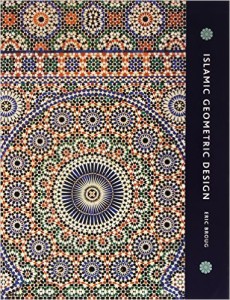
Eric Broug’s Islamic Geometric Design (Thames and Hudson, 2013) is as big and beautiful as Luca Mozzati’s Islamic Art. Like that book, it goes some way towards correcting the bias – the total blind spot to be frank – in Lynn Gamwell’s otherwise splendid Mathematics + Art on all things Islamic.
Broug’s focus is sharply on how to create such designs: both, how the Islamic craftsmen who made them did their job centuries ago, and how you can do it today. The book ends, indeed, with an Appendix of some 50 pages on “How to create designs”. The body of the book looks at Basic Design Principles, Grids and Polygons, and then 4-fold, 6-fold, 5-fold, and Combined Geometric Design. The focus is thus on geometry pure and simple, referring from there briefly to the history of each object covered.
Unfortunately, although the cover shows a fine example of Moroccan “zellige” tilework, the book is almost entirely devoted to the more rule-based geometric strapwork called girih, which one may guess was more interesting to someone like Broug, who plainly likes a tough geometric puzzle to solve. Girih can, it seems, be constructed either as was traditionally supposed simply with a ruler and compasses, or, intriguingly, with a small set of “tiles” (conceptual rather than ceramic), which can be assembled and arranged in an almost infinite variety of ways, including aperiodically (a fascinating aspect if you’re a mathematical physicist).
Many of the objects analysed in the book are walls, ceilings or domes of buildings, such as mosques, medersas and mausoleums. Happily, however, many other examples are taken from woodwork including minbars (pulpits), bronze doors, tiles and screens, with the occasional plate. Broug is mainly interested in the very strictly geometric Girih strapwork designs, which can be analysed rather thoroughly with geometry; he is less interested in the far less mathematical Zellige of Morocco, arabesques, or calligraphy, which are all important forms of Islamic decoration; and he does not concern himself with the making of artefacts such as glass, ceramics, paintings, or metal objects except insofar as they are geometrically patterned.
